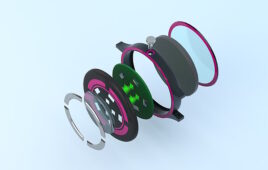Panacol, a manufacturer of industrial, UV, conductive, and medical-related adhesives, has developed a range of new one-component epoxy adhesives that cure at extremely low temperatures.

The new Structalit 5511 is ideal for use in electronics and connector sealing (the adhesive is shown in light blue in the graphic).
These new adhesives were developed specifically for electronics applications and adhere well to substrates with low surface energy.
With the adhesives Structalit 5511, 5521, and 5531, a range of adhesives has been developed that exhibit a unique set of physical properties after reaching full cure. This permits optimizing the adhesive with various component geometries, substrates, and operating functions.
All three adhesives are single-component, epoxy resin-based adhesives and cure at just 60° C, making them particularly suitable for temperature-sensitive electronic components. Curing at higher temperatures will accelerate cure time and add additional strength to the bond.
Structalit 5511 features a particularly low ionic content and is, therefore, suitable for use in electronics. Combining a high Young’s modulus with an elongation at break of more than eight percent, it ensures high adhesion to many substrates with additional shock and vibration resistance.
Structalit 5521 is softer and more flexible after curing, allowing the adhesive to better compensate for stresses between substrates. Due to its low modulus of elasticity, this adhesive is ideal for potting or for the application of thicker adhesive layers.
As the third adhesive of the new epoxy technology, Structalit 5531 has an extraordinary low coefficient of thermal expansion (CTE), yet is flexible enough to withstand drop and vibration tests. The incorporation of filler particles gives the adhesive extremely high resistance to mechanical and chemical influences.
These Structalit adhesives from Panacol generate very high bond strength with materials typically used in the electronics industry. They can also adhere well to LCP (liquid crystal polymer) and other high-tech plastics with low surface energy. All three adhesives possess high purity and low ion content, which complies with international standards for electronic and microelectronic component assembly.





Tell Us What You Think!